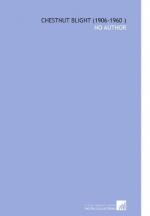|
This section contains 330 words (approx. 2 pages at 300 words per page) |
The American chestnut (Castanea dentata) formerly was the most prevalent tree in the mountains of the eastern United States, comprising more than 25 percent of the forest. Chestnut was a fast growing, valuable tree. Its wood was used in all phases of construction, from rough timbers and telephone poles to fine furniture; its bark was a source of tannins for making leather; and its nuts provided nourishment for wildlife, livestock, and people.
The chestnut blight fungus (Cryphonectria parasitica) was introduced into North America at the beginning of the twentieth century, probably on imported Japanese chestnut seedlings. The blight fungus swept through the chestnut forests, killing approximately ten billion trees by the middle of the century. Fewer than one hundred trees within the original range survived the onslaught of blight. This level of destruction of an entire, well-established species by a disease is unparalleled in the annals of plant and animal pathology.
The blight fungus kills chestnut trees by destroying the phloem and outer layers of xylem, growing around the tree trunk at a rate of approximately 15 centimeters per year. When all the bark and underlying wood around a trunk is killed, the tree dies because it can no longer circulate water and sugar between its leaves and roots.
Millions of chestnut sprouts persist today in the Appalachian Mountains, escaping blight due to their small size (although they are still susceptible to the disease). These are being used as mother trees in an effort to backcross the blight resistance of the Chinese chestnut tree into its American cousin. Scientists also have found some viruses that attack the blight fungus, making it unable to kill trees. It is hoped that one or both of these approaches will allow the return of this noble tree.
See Also
Interactions, Plant-Fungal; Pathogens.
Bibliography
Griffin, G. J. "Blight Control and Restoration of the American Chestnut." Journal of Forestry 98 (2000): 22-7.
Smith, D. M. "American Chestnut: Ill-Fated Monarch of the Eastern Hardwood Forest." Journal of Forestry 98 (2000): 12-15
|
This section contains 330 words (approx. 2 pages at 300 words per page) |


